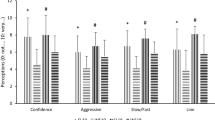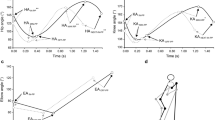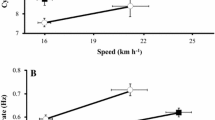Abstract
Dynamic forces and range of motion (ROM) were measured during on-ice skating using a standard hockey skate and a modified skate (MS) with an altered tendon guard and eyelet configuration. The objective of this study was to determine if these modifications resulted in biomechanical and performance changes during on-ice skating skills. The right skate of each type was instrumented with a calibrated strain gauge force transducer system to measure medial–lateral and vertical forces during ice skating. In addition, a goniometer was placed about the ankle and rear foot to measure ROM during skating. Ten subjects executed three skills: forward skating, crossovers inside foot and crossovers outside foot. The MS demonstrated significant gains of 5°–9° in dorsi-plantarflexion ROM (p < 0.05). Total peak force occurred later during plantarflexion, suggesting a more prolonged and effective force generation with the MS during a given skating stride. A 14–20 % increase (p > 0.05) in mean work and power output was noted with the MS, although no improved times were observed during the skating skills. Potentially, some players may need a period of familiarization to take advantage of the design alterations of the MS.








Similar content being viewed by others
References
Pearsall DJ, Turcotte RA, Murphy S (2000) Biomechanics of ice hockey. In: Garrett WE, Kirkendall DT (eds) Exercise and sport science. Lippincott Williams & Wilkins, Philadelphia, pp 675–692
Federolf PA, Mills R, Nigg B (2008) Ice friction of flared ice hockey skate blades. J Sports Sci 26(11):1201–1208
Renger R (1994) Identifying the task requirements essential to the success of a professional ice hockey player: a scout’s perspective. J Teach Phys Educat 13:180–195
Twist P, Rhodes T (1993) The bioenergetic and physiological demands of ice hockey. Natl Strength Cond Assoc J 15(5):68–70
Minkoff J (1982) Evaluating parameters of a professional hockey team. Am J Sports Med 10(5):285–292
Marino GW (1983) Selected mechanical factors associated with acceleration in ice skating. Res Q Exerc Sport 54(3):234–238
Bracko MR (2001) On-ice performance characteristics of elite and non-elite female ice hockey players. J Strength Cond Res 15(1):42–47
Montgomery DL, Nobes K, Pearsall DJ, Turcotte RA (2004) Task analysis (hitting, shooting, passing, and skating) of professional hockey players. In: Pearsall DJ, Ashare AB (eds) Safety in ice hockey: fourth volume. ASTM International, West Conshohocken, PA, pp 288–295
Goodman N, Goodman A (1882) Handbook for fenskating. Low, Marston, Scarle and Rivington, London
Minetti A (2004) Passive tools for enhancing muscle-driven motion and locomotion. J Exp Biol 207:1265–1272
Houdjik H, de Koning JJ, de Groot G, Bobbert MF, van Ingen Schenau GJ (2000) Push-off mechanics in speed skating with conventional skates and klapskates. Med Sci Sports Exerc 32(3):635–641
van Ingen Schenau GJ, de Groot G, Scheurs AW, Meester H, de Koning JJ (1996) A new skate allowing powerful plantar flexion improves performance. Med Sci Sports Exerc 28(4):531–535
Jobse H, Schuurhof R, Cserep F, Schreurs AW, de Koning JJ (1990) Measurement of push-off force and ice friction during speed skating. Int J Sport Biomech 6:92–100
Stidwill TJ, Pearsall D, Turcotte R (2010) Comparison of skating kinetics and kinematics on ice and on a synthetic surface. Sports Biomech 9(1):57–64
Lamontagne M, Gagnon M, Doré R (1983) Développement, validation et application de systèmes de patins dynamométriques. Can J Sport Sci 8(3):169–183
Pearsall DJ, Turcotte RA, Lefebvre R, Bateni H, Nicolaou M, Montgomery DL, Chang R (2001) Kinematics of the foot and ankle during forward ice hockey skating. In: Proceedings from XIX international symposium on biomechanics in sports. San Francisco, USA, ISBS, pp 78–81
Dewan C (2004) Dynamic pressure measurement around foot and ankle during forward acceleration and skating. Unpublished Master’s thesis, Department of kinesiology and physical education, McGill University, Montreal, Canada
de Boer RW, Cabri J, Vaes W, Clarijs JP, Hollander AP, de Groot G, van Ingen Schenau GJ (1987) Moments of force, power, and muscle coordination in speed skating. Int J Sports Med 8:371–378
de Koning JJ, de Groot G, van Ingen Schenau GJ (1992) Ice friction during speed skating. J Biomech 25(6):565–571
de Koning JJ, Thomas R, Berger M, de Groot G, van Ingen Schenau GJ (1995) The start in speed skating: from running to gliding. Med Sci Sport Exerc 27:1703–1708
Yoneyama T, Scott N, Nagawa H, Osada K (2008) Ski deflection measurement during skiing and estimation of ski direction and edge angle. Sports Eng 11:2–13
Upjohn T, Turcotte RA, Pearsall D, Loh J (2008) Three-dimensional kinematics of the lower limb during forward ice hockey skating. Sports Biomech 7(2):205–220
Rowe PJ, Myles CM, Hillmann SJ, Hazlewood ME (2001) Validation of flexible electrogoniometry as a measure of joint kinematics. Physiotherapy 87(9):479–488
Hoshizaki TB, Kirchner G, Hall K (1989) Kinematic analysis of the talocrural and subtalar joints during the hockey skating stride. In: Castaldi CR, Hoerner EF (eds) Safety in ice hockey, ASTM STP 1050. American Society for Testing and Materials, Philadelphia
Marino GW (1977) Kinematics of ice skating at different velocities. Res Q 48(1):93–97
van Ingen Scheanu GJ, de Groot G, de Boer RW (1985) The control of speed in elite female speed skaters. J Biomech 18(2):91–96
Haguenauer M, Legreneu P, Monteil KM (2006) Influence of figure skating skates on vertical jumping performance. J Biomech 39(4):699–707
Bobbert MF, van Ingen Schenau GJ (1988) Coordination in vertical jumping. J Biomech 21:249–262
Ounpuu S (1990) The biomechanics of running: a kinematic and kinematics analysis. Instr Course Lect 39:305–318
Pearsall DJ, Paquette M, Baig Y, Albrecht Z, Turcotte RA (2012) Ice hockey skate boot mechanics: direct torque and contact pressure measures. Proced Eng 34:295–300
Millet G, Perrey S, Robin C, Belli A, Borrani F, Rouillon JD (1998) External loading does not change energy cost and mechanics of rollerski skating. Eur J Appl Physiol 78:276–282
Stidwill TJ, Turcotte RA, Dixon P, Pearsall DJ (2010) Force transducer system for measurement of ice hockey skating force. Sports Eng 12:63–68
Woolfson MM, Woolfson MS (2007) Mathematics for physics. Oxford University Press Inc., Oxford
van Ingen Schenau GJ, de Boer GW, de Groot G (1989) Biomechanics of speed skating. In: Vaughn CL (ed) Biomechanics of sport. CRC Press, Boca Raton, FL, pp 121–167
Houdjik H, Wijker AJ, de Koning JJ, Bobbert MF, de Groot G (2001) Ice friction in speed skating: can klapskates reduce ice frictional loss? Med Sci Sports Exerc 33(3):499–504
de Koning JJ, de Groot G, van Ingen Schenau GJ (1991) Coordination of leg muscles during speed skating. J Biomech 24(2):137–146
Acknowledgments
We would like to thank Bauer Hockey Corp. and Natural Sciences and Engineering Research Council of Canada for their financial support of this project.
Author information
Authors and Affiliations
Corresponding author
Rights and permissions
About this article
Cite this article
Robert-Lachaine, X., Turcotte, R.A., Dixon, P.C. et al. Impact of hockey skate design on ankle motion and force production. Sports Eng 15, 197–206 (2012). https://doi.org/10.1007/s12283-012-0103-x
Published:
Issue Date:
DOI: https://doi.org/10.1007/s12283-012-0103-x




